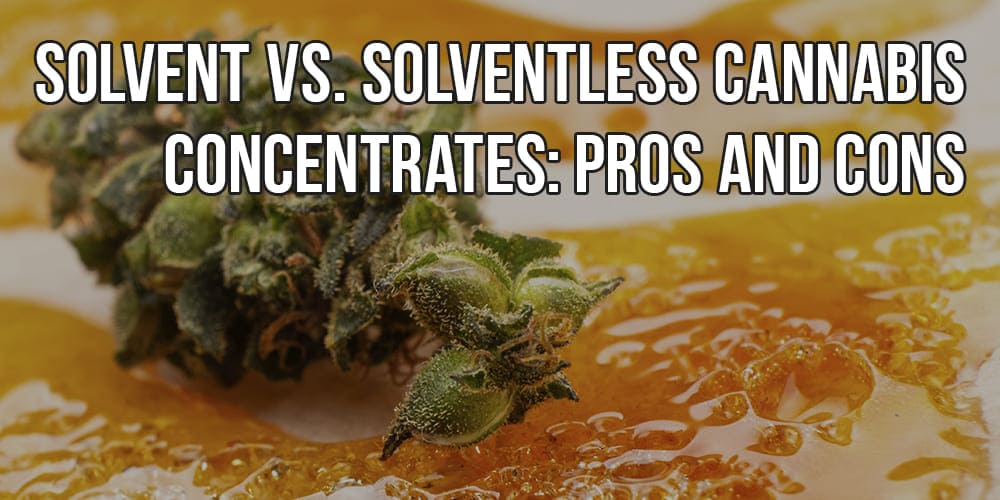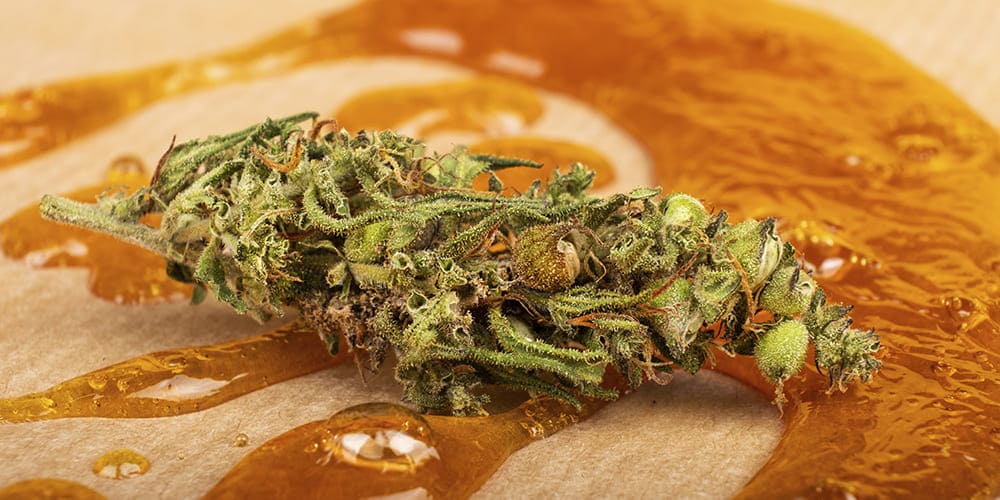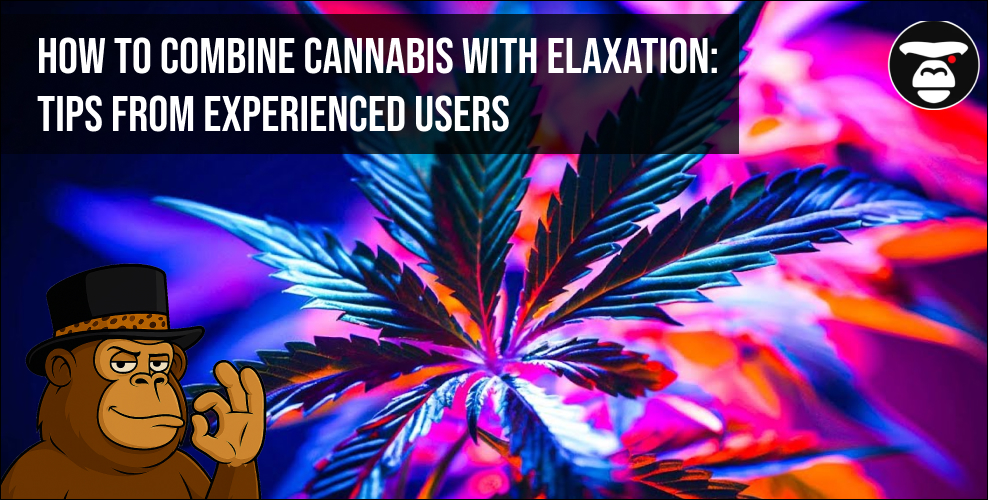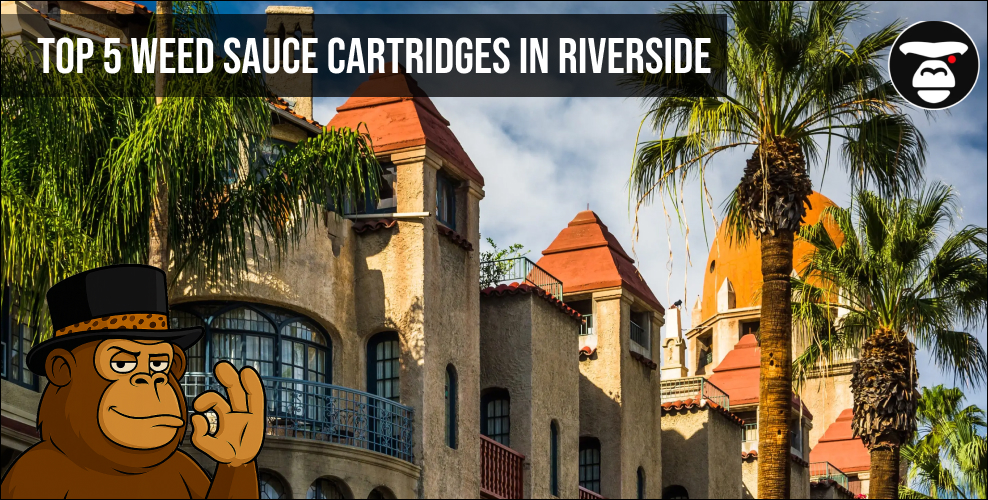Solvent vs. Solventless Cannabis Concentrates

Cannabis extraction is a method used to isolate and collect compounds from the plant, mainly from its trichomes, which contain cannabinoids and terpenes. These compounds are most abundant in the flowers of the plant.
There are two primary techniques for cannabis extraction: solvent-based and solventless. Each method has its own benefits and uses, depending on the desired end product and its intended application.
In the following discussion, we will outline the specifics of these techniques and provide information on selecting between solvent-based and solventless cannabis extraction.
For those who are interested in cannabis concentrates, we recommend reading these articles:
- Understanding Shatter: What It Is and How to Use It
- How live resin is made?
- Understanding Budder: A Cannabis Concentrate
Cannabis Extraction Simplified

Cannabis extraction is a process used to isolate compounds, primarily cannabinoids and terpenes, from the cannabis plant. These compounds are concentrated in trichomes, which are small structures found mainly on the plant’s flowers and leaves.
The main starting material for extraction is the cannabis flower due to its high trichome content. After preparing the plant material, the next step is to separate the trichomes and collect the desired compounds.
There are two main extraction techniques: solvent-based extraction and solventless extraction. Each has specific applications and outcomes, and the choice between them depends on the desired end product.
Solvent-based extraction uses chemical solvents to separate the compounds, while solventless extraction relies on mechanical methods. Both aim to produce concentrated cannabis products, but the methods and results can differ significantly. The discussion of “solvent vs. solventless” is a central topic in the field of cannabis extraction, with each having its proponents and specific use cases.
Indulge in the captivating experience of Kiwi, an enchanting indica-dominant strain that promises a gentle yet profoundly effective high. With Kiwi, relaxation reigns supreme, delivering a soothing embrace that leaves your mind clear and your body blissfully mellow.
Explore the delightful symphony of flavors it offers, from the zesty notes of Green Sour Lemonade to the subtle hints of pine and the refreshing essence of bay leaf. Elevate your cannabis journey with Kiwi, and let its unique charm sweep you away.
Solvent Extraction

Cannabis extraction is essentially the art of unlocking the cannabis plant’s valuable compounds. At its heart are trichomes, the minuscule hair-like structures found on the plant’s leaves and flowers. Trichomes are nature’s treasure troves, storing the cannabinoids and terpenes that give cannabis its unique flavors and effects.
The journey of cannabis extraction typically begins with hand-picked cannabis flowers, which are abundant in trichomes, making them the ideal starting material.
To separate these precious trichomes from the rest of the plant material, extraction techniques come into play, presenting two primary options: solvent-based and solventless methods.
In solvent-based extraction, chemical solvents like ethanol, carbon dioxide (CO2), and hydrocarbons (such as butane and propane) are employed. These solvents are instrumental in crafting various cannabis concentrates, including distillate, shatter, and live resin.
Moreover, they can be refined for use in diverse products like tinctures, vape e-liquids, and edibles.
Ethanol, commonly found in alcoholic drinks, is a popular choice for its safety and ease of use. It is embraced by both large-scale manufacturers and individual cannabis extractors. Ethanol’s versatility is its trump card, as it can dissolve a broad spectrum of substances, even the often-overlooked flavonoids found in cannabis.
However, its extensive capabilities might also extract less desirable elements, like chlorophyll, potentially introducing unwanted flavors.
Hydrocarbon-based extraction excels in efficiency. It excises waxes and undesirable compounds, yielding potent extracts that require minimal post-processing.
Nevertheless, it carries higher risks due to the flammable nature of hydrocarbon solvents. Concerns may arise about traces of residual solvents in the final product, even if they meet safety standards.
CO2 extraction, alternatively, utilizes high pressures and precise temperatures to transform carbon dioxide into an effective solvent. Praised for its cleanliness and safety, this method is highly customizable, allowing the extraction of various compounds.
It is, however, considered less cost-effective than ethanol and hydrocarbon extraction, requiring specialized, costly equipment.
In the realm of “solvent vs. solventless,” the choice fundamentally alters the characteristics of the final cannabis product, impacting purity, flavor, and overall user experience.
Understanding these key differences and benefits between these two approaches is crucial for both seasoned cannabis enthusiasts and newcomers to the world of cannabis extraction.
Solventless Extraction

Solventless extraction methods represent a unique approach to liberating cannabis trichomes from the plant without resorting to chemical solvents, a characteristic highly valued by consumers who prioritize cleanliness and safety in their cannabis products.
However, it’s crucial to understand that solventless extraction is often limited in scalability, making it particularly suited for crafting small, artisanal batches of exquisite cannabis products like hash and rosin.
One prominent example is cold water extraction, which leverages the power of ice and cold water to gently dislodge trichomes from the plant material. Because trichomes resist dissolving in water, they can be readily separated and subsequently dried.
Another widely embraced technique involves the rosin press, employing a precise blend of heat and pressure to extract trichomes from the cannabis plant.
Solventless methodologies extend to a variety of methods, including grinders, screens, and even the time-honored practice of hand-rolling for hash production.
Although hand-rolled hash is less frequently encountered on dispensary shelves, it showcases the diverse and nuanced world of solventless cannabis extraction, providing a unique spectrum of products to meet the preferences of cannabis enthusiasts.
In the ongoing debate of “solvent vs. solventless,” understanding the characteristics and advantages of these two approaches is pivotal for making informed choices in the world of cannabis extraction.
Introducing Watermelon, the captivating indica strain often referred to as “Watermelon Kush” or “Watermelon OG.” This delightful strain delivers a wave of relaxation, perfect for those seeking peaceful sleep or a boost in appetite.
Dive into the soothing embrace of Watermelon’s effects, and savor the experience like biting into a juicy, ripe watermelon on a hot summer day.
Solvent vs. Solventless

Cannabis extraction methods encompass a wide array of approaches, each presenting its unique set of merits, limitations, and final product outcomes.
It’s essential to recognize that there isn’t a universally superior extraction method; rather, the choice hinges on individual requirements and preferences. Consequently, many cannabis companies adopt a blend of techniques to accommodate the diverse needs of their clientele.
Nonetheless, there exist valuable recommendations for consumers. If apprehensive about residual solvents, it is prudent to steer clear of products manufactured through ethanol or hydrocarbon extraction processes.
Conversely, individuals in pursuit of the most robust flavors, minimal processing, or artisanal cannabis products will likely find solace in solventless alternatives.
In the ongoing conversation of “solvent vs. solventless,” understanding the nuances and distinctions between these methodologies is pivotal in making informed decisions within the realm of cannabis extraction.
Embrace the allure of APE Premium Cannabis’s exclusive collection of Live Resin Sugar Diamonds, a fusion of nature’s perfection and cutting-edge technology. Live Resin isn’t merely a process; it’s a celebration of the plant’s very soul.
By capturing the essence immediately after harvesting, Live Resin technology preserves the vibrancy, aroma, and integrity of the cannabis like a painter traps emotion on canvas.
In the ever-evolving world of cannabis extraction, the choice between solvent-based and solventless methods is a nuanced decision, much like selecting the perfect strain for your preferences. There’s no one-size-fits-all answer, as each approach holds its unique advantages and limitations.
Whether you seek the pristine flavors of solventless products or the efficiency and potency of solvent-based concentrates, your decision should align with your individual needs and priorities.
Ultimately, the cannabis industry thrives on diversity, with many companies adopting a blend of extraction techniques to cater to a broad customer base. As the landscape of cannabis continues to evolve, understanding the nuances of solvent vs. solventless extraction methods empowers consumers to make informed choices in their quest for the perfect cannabis experience.




























